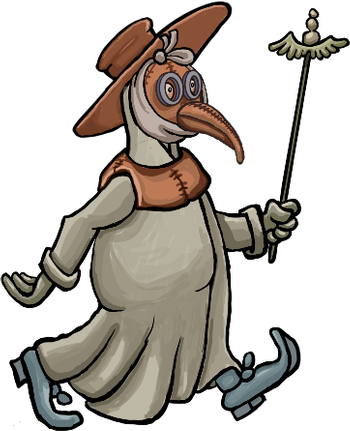Science Cartoon - History of Science:Masks

During Medieval times, plague doctors wore a beak-like mask during a pandemic. These masks were filled with aromatic items. The discovery of the "beak-like masks" is attributed to Charles de Lorme, who Charles was the chief physician of three French kings, Henri IV, Louis XIII, and Louis XIV from 1610 to 1650. He developed in 1619 the idea of a full head-to-toe protective garment for doctors [1]. The garments consisted of a bird-like mask with spectacles and a long waxed leather gown, which went from the neck to the ankle.
These beak-like masks were designed to protect the plague doctors from putrid air based on the miasmatic theory of disease. The theory held that the origin of epidemics was due to a miasma, emanating from rotting organic matter. Until 1850s, miasma was used to explain the spread of diseases.
Florence Nightingale (1820–1910) was a strong supporter of the miasmatic theory. Nightingale is known for her role during The Crimean War (1853 - 1856) between Russia and the alliance made up of the Ottoman Empire, France, the United Kingdom and Sardinia. She made sure that hospitals are sanitary and fresh-smelling [2].
During 1850 cholera pandemic in London and in Paris, they believed that cholera was transmitted by air, and there was a deadly concentration of miasmata near rivers. John Snow, who is considered one of the founders of modern epidemiology, traced the source of a cholera as a water pump in Soho, London in 1854 demonstrating that cholera was spread through water [3].
References
[1] Vidal, Pierre; Tibayrenc, Myrtille; Gonzalez, Jean-Paul (2007). "Chapter 40: Infectious disease and arts". In Tibayrenc, Michel (ed.). Encyclopedia of Infectious Diseases: Modern Methodologies. John Wiley & Sons.
[2] McDonald, Lynn, ed. Florence Nightingale’s Suggestions for Thought: Collected Works of Florence Nightingale. Vol. 11. Wilfrid Laurier Univ. Press, 2008.
[3] Cameron, Donald, and Ian G. Jones. "John Snow, the Broad Street pump and modern epidemiology." International journal of epidemiology 12, no. 4 (1983): 393-396.
By:
Ergun Akleman
Departments of Visualization & Computer Science and Engineering
Texas A&M University, College Station, TX 77845
URL: people.tamu.edu/~ergun
Email: ergun.akleman@gmail.com, ergun@tamu.edu